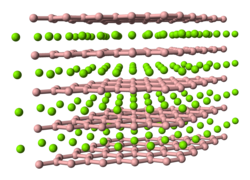Hafnium diboride
| Crystal structure | ||||||||||||||||
|---|---|---|---|---|---|---|---|---|---|---|---|---|---|---|---|---|

|
||||||||||||||||
| __ Hf __ B | ||||||||||||||||
| General | ||||||||||||||||
| Surname | Hafnium diboride | |||||||||||||||
| Ratio formula | HfB 2 | |||||||||||||||
| Brief description |
gray solid |
|||||||||||||||
| External identifiers / databases | ||||||||||||||||
|
||||||||||||||||
| properties | ||||||||||||||||
| Molar mass | 200.11 g mol −1 | |||||||||||||||
| Physical state |
firmly |
|||||||||||||||
| density |
10.5 g / cm³ (25 ° C) |
|||||||||||||||
| Melting point |
3100 ° C |
|||||||||||||||
| solubility |
practically insoluble in water |
|||||||||||||||
| safety instructions | ||||||||||||||||
|
||||||||||||||||
| As far as possible and customary, SI units are used. Unless otherwise noted, the data given apply to standard conditions . | ||||||||||||||||
Hafnium diboride is an inorganic chemical compound of hafnium from the group of borides . In addition to this, two other hafnium borides are known: hafnium monoboride HfB and hafnium dodecaboride HfB 12 .
Extraction and presentation
Hafnium diboride can be obtained by reacting hafnium dioxide with carbon and boron trioxide or boron carbide . It can also be produced by reacting mixtures of hafnium tetrachloride , boron trichloride and hydrogen at temperatures above 2000 ° C or directly from the elements.
Electrochemical processes are known for the deposition of thin layers of hafnium diboride.
properties
Hafnium diboride is a gray solid that is practically insoluble in water. The compound is attacked by hydrofluoric acid , but is resistant to almost all other reagents at room temperature. It only oxidizes at temperatures above 1500 ° C. The Vickers hardness is between 2200 and 2900. Hafnium diboride has a hexagonal crystal structure of the aluminum diboride type C32 with the space group P 6 / mmm (space group no. 191) . Its specific resistance is 15 µΩ · cm and its hardness is 29 GPa.
use
Hafnium diboride is used in wear-resistant coatings. It is also used as a material for control rods in nuclear reactors and as a material for ICBM - heat shields or aerodynamic leading edges. It is also a component of high-temperature composite materials in conjunction with silicon carbide . It is also used as a material for heating elements in nozzles in inkjet printers.
Individual evidence
- ↑ a b c d e f Data sheet Hafnium boride, powder, −325 mesh, 99% trace metals basis from Sigma-Aldrich , accessed on February 26, 2018 ( PDF ).
- ↑ a b c Data sheet Hafnium boride, 99.5% (metals basis excluding Zr), Zr <2% from AlfaAesar, accessed on February 26, 2018 ( PDF )(JavaScript required) .
- ↑ a b c Eula Bingham, Barbara Cohrssen: Patty's Toxicology . John Wiley & Sons, 2012, ISBN 0-470-41081-7 , pp. 463 ( limited preview in Google Book search).
- ↑ Marcelle GAUNE-Escard, Kenneth R. Seddon: Molten Salts and Ionic Liquids Never the Twain? John Wiley & Sons, 2012, ISBN 0-470-94776-4 , pp. 197 ( limited preview in Google Book search).
- ↑ Michael McNallan: High Temperature Corrosion and Materials Chemistry Proceedings of the Per Kofstad Memorial Symposium . The Electrochemical Society, 2000, ISBN 978-1-56677-261-7 , pp. 490 ( limited preview in Google Book search).
- ↑ Ian Hutchings, Philip Shipway: Tribology Friction and Wear of Engineering Materials . Butterworth-Heinemann, 2017, ISBN 978-0-08-100951-2 , pp. 171 ( limited preview in Google Book search).
- ^ John W. Lawson, Murray S. Daw, Charles W. Bauschlicher: Lattice thermal conductivity of ultra high temperature ceramics ZrB 2 and HfB 2 from atomistic simulations. In: Journal of Applied Physics. 110, 2011, p. 083507, doi : 10.1063 / 1.3647754 .
- ↑ a b Sreenivas Jayaraman, Y. u. Yang, Do Young Kim, Gregory S. Girolami, John R. Abelson: Hafnium diboride thin films by chemical vapor deposition from a single source precursor. In: Journal of Vacuum Science & Technology A: Vacuum, Surfaces, and Films. 23, 2005, p. 1619, doi : 10.1116 / 1.2049307 .
- ↑ Loehman, RE. (2004). Ultra-high-temperature ceramics for hypersonic vehicle applications . 71.
- ↑ DS Wuu, ML Lee, TY Lin, RH Horng: Characterization of hafnium diboride thin film resistors by rf magnetron sputtering. In: Materials Chemistry and Physics. 45, 1996, p. 163, doi : 10.1016 / 0254-0584 (96) 80096-4 .

